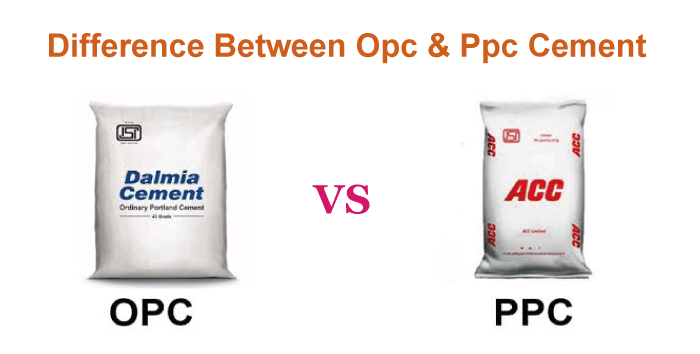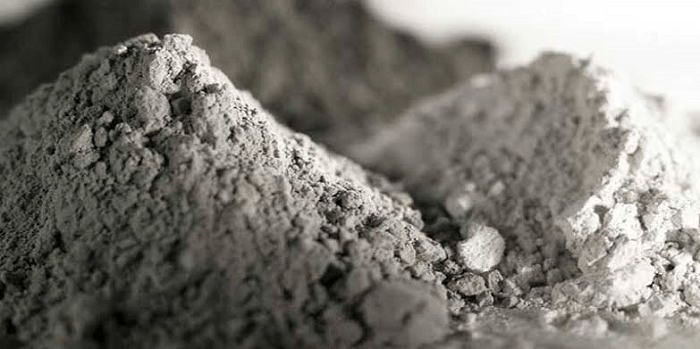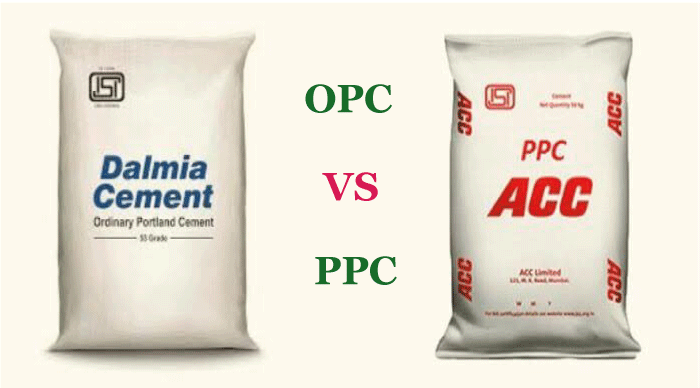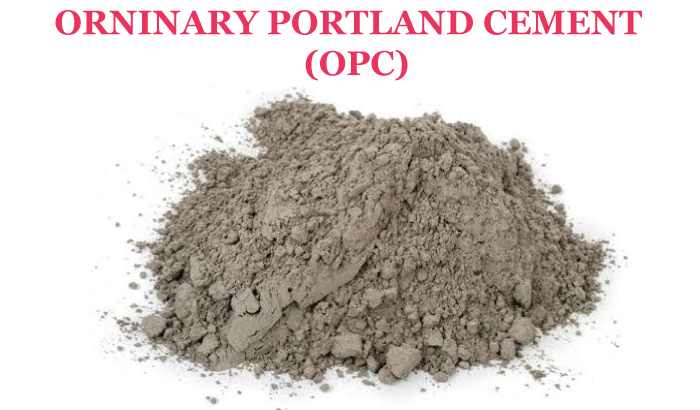Difference Between OPC and PPCPortland cement is the world's most widely used type of cement, acting as a foundational ingredient in stucco, concrete, mortar, and non-specialty grout. In the early 19th century, Joseph Aspdin developed it from other varieties of hydraulic lime in England and it is commonly created from limestone. It is a fine powder that is produced by heating limestone and clay minerals in klin to produce clinker, then grinding the clinker with adding 2 to 3% gypsum. 
There are several types of Portland cement. The most common is Ordinary Portland cement (OPC) which is usually in grey, however white Portland cement is also accessible. It was named after the Portland stone which was quarried on Dorset's Isle of Portland. Joseph Aspdin who named it and got a patent for it in 1824. Because of his discoveries in the 1840s, his son William Aspdin is regarded as the creator of "modern" Portland cement. Because of the low cost and extensive availability of the shales, limestone, and other materials that are naturally occurring will be needed in manufacturing of Portland cement to produce cheap inexpensive building material. Its most common usage in production of concrete, a composite material of aggregate (gravel and sand), cement, and water. Portland cement Manufacturing ProcessPortland cement clinker is produced by heating a raw material mixture in a cement kiln to a calcining temperature of more than 600 °C (1,112 °F) and then to a fusion temperature of about 1,450 °C (2,640 °F) for modern cement to sinter the materials into clinker. Cement clinker contains alite, belite, tricalcium aluminate, and tetra calcium alumino ferrite. Aluminium, iron, and magnesium oxides act as a flux allowing calcium silicates to form at lower temperatures while contributing only a little amount of strength. Limiting the formation of tricalcium aluminate (3 CaOAl2O3) is required for particular cements such low heat (LH) and sulphate resistance (SR). 
Limestone (CaCO3) is the major raw material for clinker manufacturing, and it is combined with a second material including clay as an alumino-silicate source. Impure limestone which contains SiO2 or clay is commonly used. These limestones can have CaCO3 content as low as 80%. The quality of the limestone has an impact on secondary raw materials. (Materials other than limestone in the raw mix). Some of the materials are utilised are clay, iron ore, shale, sand, fly ash, bauxite, and slag. Coal ash is used as a secondary raw material when cement kilns are fired by coal. Usage of Portland CementPortland cement is the most often used cement in the production of concrete. Concrete is a material that is made up of aggregate (gravel and sand) cement as well as water. As construction material, concrete can be utilised practically in any shape required and once solidified it can become a structural (load bearing) element. Concrete can be used to make structural pieces such as panels, beams, furniture for streets, or superstructures such as highways and dams. They can be supplied with on-site ready-mixed concrete or concrete produced at permanent mixing plants. 
Portland cement is also used in mortars (which contain only sand and water), plasters or screeds, and grouts (cement/water combinations that are squeezed into gaps to strengthen foundations, road-beds, and other kinds of structures). When water and Portland cement are mixed, the mixture hardens over time and solidifies in a matter of hours. These procedures vary widely depending on the mix used and the product's curing conditions, but standard concrete sets in about 6 hours and achieves an 8 MPa compressive strength in 24 hours. After three days, the strength increases to 15 MPa, 23 MPa after one week, 35 MPa shortly after four weeks, and 41 MPa after three months. Theoretically, strength increases slowly as long as the water is available for further hydration. However, after a few weeks, concrete is normally allowed to dry out, causing strength growth to stop. OPC CementThe most prevalent type of cement in the construction sector is ordinary Portland cement, or OPC cement. It is produced by grinding clinker (a mixture of limestone, clay, and other minerals) with gypsum, which regulates the setting time and increases the cement's final strength. Because of its great compressive strength, it is useful for bridge construction and other infrastructure projects. 
OPC cement is available in several grades ranging from OPC 33 to OPC 53, with higher grades indicating greater compressive strength. The specific application and project requirements determine the grade selected. OPC cement is well-known for its long life, chemical resistance, and low hydration temperature. However, it has significant disadvantages such as excessive consumption of energy during production and a large carbon impact. As a result, there is a growing interest in environmentally friendly cement formulations such as blended cement and geopolymer cement. Advantages of OPC Cement
Disadvantages of OPC Cement
PPC CementPPC cement often known as Portland Pozzolana Cement is a popular construction material. It is a blend of Portland cement clinker, gypsum, and pozzolanic materials, including fly ash, volcanic ash, and silica fumes. Pozzolanic materials are added to cement mixtures to improve their properties and make them more durable. 
The high strength, durability, and resistance to corrosion and cracking of PPC cement are well acknowledged. It is also more environmentally friendly than other types of cement because it uses waste materials like fly ash that would otherwise be disposed of in landfills. PPC cement is widely used in bridges, dams, buildings, and other structure construction. It also produces precast products like pipes, tiles, and blocks. Advantages of PPC
Disadvantages of PPC
Similarities Between OPC Cement and PPC CementThere are two types of cement which are commonly used in the construction industry those are OPC (Ordinary Portland Cement) and PPC (Portland Pozzolana Cement). The following are some similarities between OPC and PPC
Both OPC and PPC comprise a mixture of calcium, silica, alumina and iron oxide, which are the primary chemical ingredients of cement.
OPC and PPC are created by blending similar basic ingredients, such as limestone, clay, and gypsum.
Both OPC and PPC are produced by grinding and combining the basic components into a fine powder, which is then combined with water to make a paste. Proper mixing is required for both OPC and PPC to generate a homogenous paste. Incorrect mixing can lead to weak regions and decreased strength.
OPC and PPC are both employed in a variety of construction applications, including building structures, roads, bridges, and other infrastructure projects. Because of its high strength and longevity, OPC cement is ideal for structures requiring a high level of stability and load-bearing capability. However, because of the high temperatures necessary for its production, OPC cement has a higher carbon impact than PPC cement. PPC cement is also noted for its exceptional workability and chemical resilience, making it ideal for construction in tough weather conditions. Because of its corrosion resistance, it is extensively utilised in the construction of dams, bridges, and maritime structures.
OPC and PPC require proper storage to retain quality and performance. They should be kept dry to avoid moisture absorption which might reduce their strength and longevity. OPC and PPC have a shelf life of 3-4 months, after which their quality and performance may decay.
National and international standards control both OPC and PPC defining the quality characteristics and performance requirements for each type of cement.
Both OPC and PPC can gain significant strength over time. OPC reaches early strength more quickly whereas PPC may need additional curing time to achieve comparable strength levels.
OPC and PPC are offered in various grades based on their fineness. Higher grades are often finer, which might impact the workability and strength of the cement.
OPC and PPC require rigorous quality control methods to meet the stipulated performance standards. Testing the cement for chemical composition, strength, and other criteria is one example of quality control. Differences Between OPC and PPC
ConclusionOPC cement and PPC cement are used in the construction sector. OPC cement is composed of limestone, clay, and gypsum whereas PPC cement is composed of limestone, clay, and fly ash. Pozzolanic material added to PPC cement increases its strength and longevity by making it suited for structures exposed to sulphate-rich environments or marine conditions. PPC cement has a slower initial setting time and lower early strength than OPC cement, but it has greater ultimate strength. Furthermore, PPC cement is more environmentally friendly than OPC cement, emitting less CO2. The type of cement used is determined by the specific needs of the construction project and the potential environmental impact.
Next TopicDifference Between
|
 For Videos Join Our Youtube Channel: Join Now
For Videos Join Our Youtube Channel: Join Now
Feedback
- Send your Feedback to [email protected]
Help Others, Please Share










